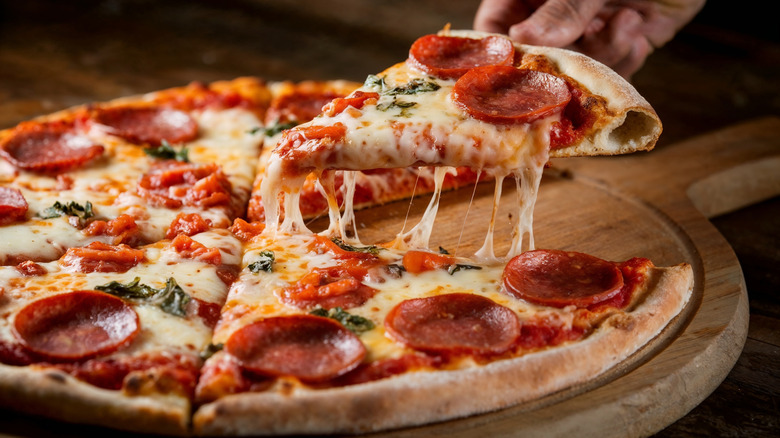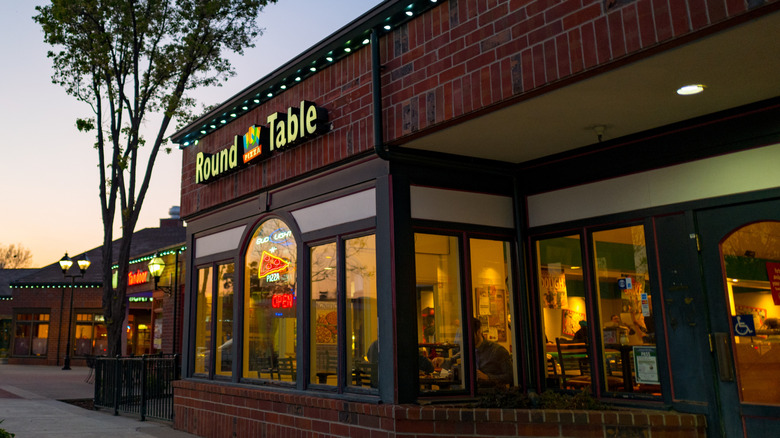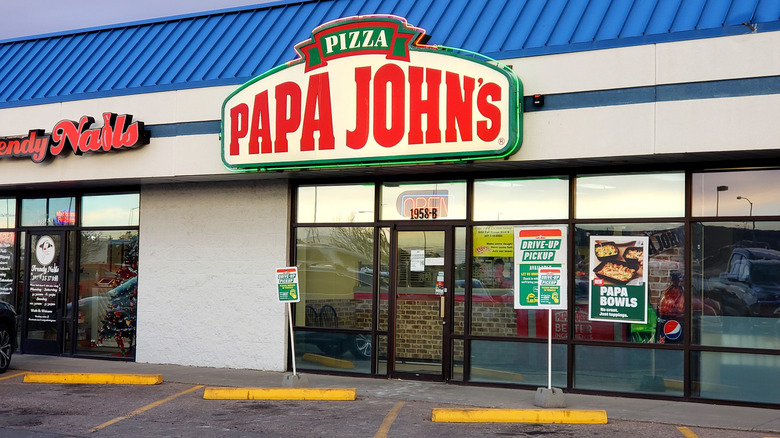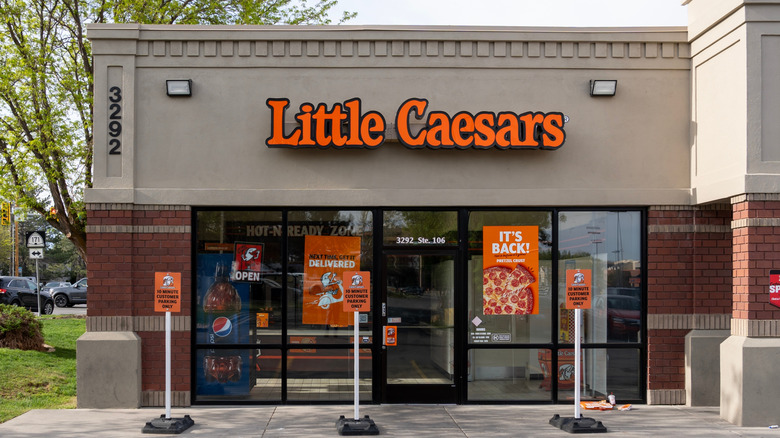Once-Struggling Pizza Chains That Made Unexpected Comebacks
Major pizza chains like Pizza Hut and Domino's have reached a level of expansion and popularity that makes them equipped to handle challenging periods and bounce back. Of course, they're not immune to setbacks. While some chains like California Pizza Kitchen have staged impressive comebacks after bankruptcies or pandemic-era struggles, others have not been as fortunate.
Pizza remains a staple in the American diet, with the average person eating it three times a month. However, it's also one of the most competitive industries in the U.S. The market is heavily saturated, with everyone after a slice of the action, from neighborhood mom-and-pop shops to classic New York joints and national chains.
Pizza is also a popular delivery meal. This gave pizzerias an advantage in the challenging COVID climate. As long as eateries could lean into the takeout model, they had a much stronger chance for survival. Naturally, some chains faced challenges before the health crisis, including declining quality and unexpected controversies. Yet, against the odds, a few struggling pizza chains managed to learn from their mistakes, realign, and make surprising comebacks: Cicis Pizza, Round Table Pizza, Papa John's, and Little Caesars.
Cicis Pizza
It's not easy for chain restaurants to bounce back after going broke, and for pizza buffets, the odds can be even tougher. The average buffet wastes up to 25% of its food, and there are notoriously slim profit margins tied to the all-you-can-eat model.
Having built its brand around this concept, Cicis was unable to seamlessly transition to a takeout model like many other pizza chains. Even prior to the pandemic, the company's sales had dropped dramatically from 2017 through 2019. Soon, the chain found itself completely underwater and made the difficult decision to file for bankruptcy in January 2021. At its peak in 2010 the chain had over 650 locations. By the time of filing, that number had dropped to less than half.
Luckily, not all was lost. In March 2021, Cicis Pizza emerged from bankruptcy and partnered with new investors. The chain credited its comeback to guest loyalty and a rejuvenated focus on tech updates, app upgrades, and curbside pickup. By the end of 2022 the company was doing much better, attracting a family-oriented clientele with new game rooms. This ultimately led to an impressive boost in business. As of 2025, Cicis Pizza is still down to 269 locations; although a far cry from its peak, the chain is in a much healthier place overall, with a 7.8% sales growth reported most recently along with plans for expansion announced in September 2024.
Round Table Pizza
Despite filing for bankruptcy in 2011, Round Table Pizza managed to keep the majority of its more than 400 restaurants open. The company filed for bankruptcy mid-recession, declaring the move was strategic and necessary to stabilize the company amid mounting debt and reduced cash flow.
By the end of that year, Round Table Pizza exited bankruptcy with a new plan. Though the recovery wasn't immediate, by 2017 the chain reported 11% growth since restructuring. Later that year, the company was acquired by Global Franchise Group after formerly being employee-owned. This partnership allowed Round Table to better allocate its resources, resulting in menu updates, revamped marketing moves, remodeled restaurants, and upgraded tech infrastructure.
As of 2024, the chain had managed to hold onto over 400 restaurants, earning a spot on PMQ's list of best-performing pizza chains of 2024, a ranking based on sales and size. With solid numbers, investor backing, and a renewed sense of direction, it's safe to say that Round Table is back to being a worthy competitor in the American market.
Papa John's
Even major chains like Papa John's aren't immune to controversy. Founded in 1984 by John Schnatter, the brand grew into one of the largest pizza franchises in the world under his leadership. Schnatter oversaw the chain for over 30 years until he was let go from the company for racially fueled commentary and slurs during company conference calls. Although he apologetically resigned from his role, he subsequently made comments blaming the company for setting him up and not conducting a proper investigation. At the same time, Papa John's saw a 16% drop in sales as partners ended contracts prematurely and general distrust for the brand grew.
Complicating matters, Schnatter continued to own 30% of the company after stepping down, leading some to question whether his departure actually signaled a moral reset for the brand. However, by 2020, Schnatter's stakes were down to just 4%. Papa John's sales reflected the turmoil. After reaching $1.783 billion in revenue in 2017, the company's earnings dipped to $1.69 billion in 2019, marking the company's first decline in over a decade.
Luckily for Papa John's the pandemic was a turning point, with revenue surging to $1.813 billion in 2020. The chain also credited its increased profit to product innovation, customer loyalty, and new partnerships, including a generously portioned Shaq-a-Roni pizza created in collaboration with basketball icon Shaquille O'Neal. Since then, Papa John's has experienced healthier growth, reporting $2.059 billion in revenue for 2024, which may have been a dip from 2023 but still signals overall stability for the brand.
Little Caesars
Little Caesars has experienced more than its fair share of ups and downs. The chain rose to prominence in the 1980s and '90s, becoming a household name thanks to its catchy "Pizza! Pizza!" slogan and memorable promotional deals. Its momentum slowed in the late '90s when Little Caesars minimized original offers and struggled with franchise management.
Throughout the 2000s and 2010s, Little Caesars made several attempts at a comeback, but many of its rebranding efforts fell flat. Critics argued the strategies failed to keep up with trends as the brand scrapped kooky favorites like the spaghetti bucket and breadsticks combo for just $8.88 — which could easily feed a family fast and for cheap. At the same time, competitors like Papa John's (once only a fourth of Little Caesars' size in the mid-1990s) steadily expanded.
But in 2020, Little Caesars found its stride in the midst of a worldwide pandemic. As consumers tightened their budgets and takeout became second nature, the chain leaned into its strengths: affordability, convenient "hot-n-ready" pizzas, and contactless ordering. The result was a significant turnaround, allowing Little Caesars to secure its place as the third-largest pizza chain in the U.S. As of 2024, things were still looking up. The brand returned to its roots with unique menu items like Crazy Puffs, increased international expansion, and formed new partnerships. The chain also announced 23 new store openings in September 2024. These recent developments indicate a strong, new chapter in Little Caesars' legacy, perhaps its best to date.




